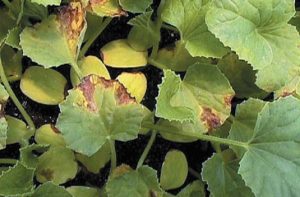The name Gene McAvoy in the Florida vegetable industry is synonymous with a true veteran of the industry. Anytime Gene speaks in front of an audience, everyone listens. This is no different! We read articles on a daily basis and every once in awhile one stands out, just like this one “Ways to Beat Bacterial Fruit Blotch to the Punch in Watermelon”
The bacterium that causes fruit blotch is Acidovorax avenae subsp. citrulli. Initial symptoms on seedlings appear as a dark, water-soaking on the lower surface of cotyledons and leaves followed by necrotic lesions, which may have chlorotic halos. Foliar symptoms can develop throughout the season. In many cases, foliar lesions are neither numerous nor distinctive and may be confused with other disorders. Leaf lesions are light to reddish brown in color and are typically located along the midrib of the leaf.
Leaf lesions in the field do not result in defoliation but are important reservoirs of bacteria for fruit infection. Fruit symptoms begin as small, water-soaked areas. These enlarge rapidly to become dark-green, irregular water-soaked lesions that measure several inches in diameter. Within days, these lesions may expand to cover the entire upper surface of the fruit. In cultivars with dark-green striped rinds, symptoms may be restricted, resulting in smaller lesions on the lighter green stripe. With age, the lesions may turn brown and crack, and a total fruit rot may develop.

Survival and Spread
Bacterial fruit blotch may be introduced into a field by infested seeds, infected transplants, volunteer watermelons, or infected wild cucurbits. Symptom development and spread is most rapid during periods when the weather is hot, humid, and sunny with afternoon thundershowers. In Florida, this usually coincides with the spring crop, and in the more northerly production areas such as Georgia, South Carolina, and Indiana, symptoms develop later in the summer.
Once present in a field, the disease can be spread by wind-driven rain and mechanical means. Initial symptoms may not be very conspicuous, and careful inspection of plants is essential for early detection of this disease. Two- to three-week-old fruit are most susceptible to bacterial invasion. Bacterium enters stomata on the fruit surface and lesions develop three to seven days later. Mature fruit are covered with a wax layer that prevents bacteria from entering into the fruit. Mature watermelons can be invaded by the fruit blotch bacterium through wounds.
Management Methods
The primary control is to use seed that has been tested and found to be free of the fruit blotch bacterium, and to obtain transplants from transplant houses free of the disease. Diseased transplants can cause severe problems because the bacterium may spread in the transplant house and result in high numbers of infected plants going into the field. Transplants may harbor the bacteria but show no symptoms.
Applications of copper fungicides can reduce the incidence of bacterial fruit blotch symptoms if initiated before fruit set. For control of other foliar diseases, copper-containing fungicides should be used in combination with broad-spectrum fungicides as per labels.
Applications should begin at first flower, or earlier, and continue until melons are mature. Thorough coverage is essential for good disease control.
Great job Gene, we couldn’t have said it better! However, if you are going to use Gene’s recommendation of using a copper, we just hope you use CS 2005!
Application Rates of CS 2005 can be found at our Watermelon Crop Page or read below.
Instructions: Begin applications prior to disease development and continue while conditions are favorable for disease development. Repeat at 5 to 7 day intervals or as needed. Use the higher rates when conditions favor disease.
Rate per Acre per 100 gal. of water – 19.2 – 25.6 oz.
PPM’s (copper) per 100 gal.of water – 75 – 100 ppm
McAvoy, G. (2019). Ways to Beat Bacterial Fruit Blotch to the Punch in Watermelon. [online] Growingproduce.com. Available at: https://www.growingproduce.com/vegetables/ways-to-beat-bacterial-fruit-blotch-to-the-punch-in-watermelon/



